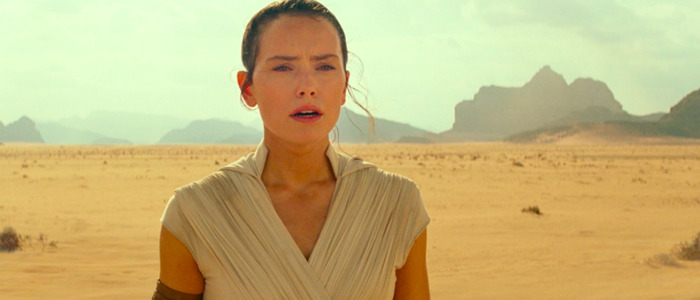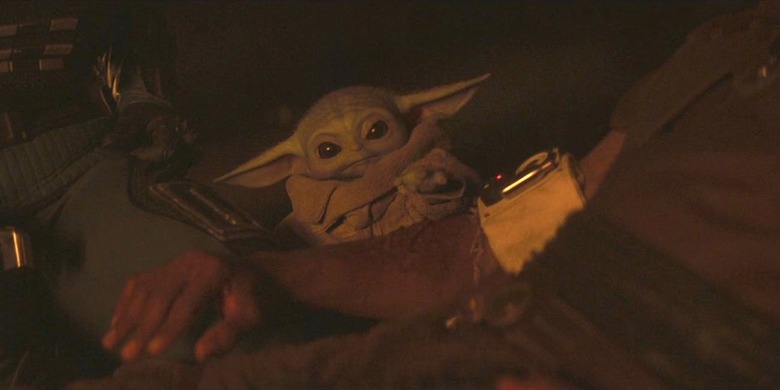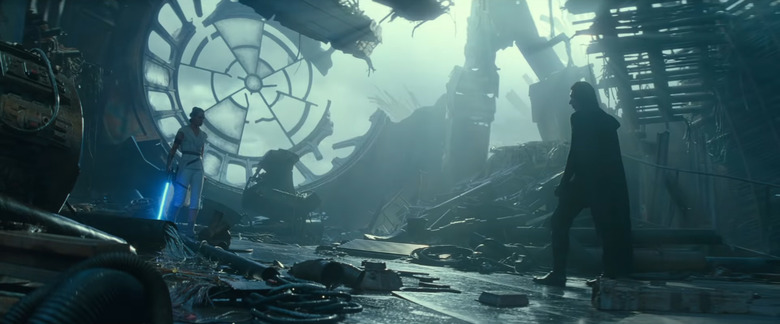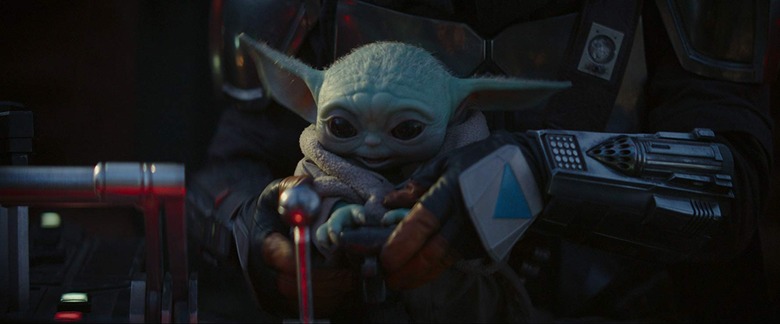'Star Wars: The Rise Of Skywalker' And 'The Mandalorian's Approaches To Force Healing Represent Different Directions For Lucasfilm's Future
Major spoilers for The Mandalorian and Star Wars: The Rise of Skywalker below.While watching Episode 7 of The Mandalorian, my partner turned to me midway through and asked, "have we seen that before?" The moment in question was when the child (aka "Baby Yoda") reached out to "Force heal" another character. I had, in fact, seen it before – during a press screening of Star Wars: The Rise of Skywalker just one day earlier. And the two properties' differing approaches to Force healing exemplify two diverging paths for Lucasfilm's future.Of all the "video game-y" additions to the Star Wars canon, where characters often need to be healed to keep going so you don't have to start the game again at the beginning, this latest uncovered power seems to be one of the more divisive additions to the live-action universe. Narratively it's of course a bit of a cheat, as it makes consequences all the more suspect when you can just heal whomever you wish. In TROS, there's a battle between two elements of this case, where Rey stabs Kylo only to bring him back, and then Ben (now freed from his anger) returns the favour, only to Force-disappear before Rey gets to keep this loop going ad infinitum. Presumably, like any vampiric tale, there will be plenty of retconning to account for any costs to a Jedi's health or even the universe in general, as the donation of Force energy surely must take off a bit off the top. It's also no surprise that it feels like the needs of a game rather than a film or show, given that this behaviour that feels akin to wireless charging was first canonized in 2015's Star Wars: Uprising. This was a mobile game that only lasted for a couple years, but it was the first (outside of the vast expanded universe that got narratively thrown away with Disney's purchase) which added in the factor of being able to bring characters back to life via waving a Jedi's hand in their general direction.If you missed that reference when watching The Rise of Skywalker, you were not alone.
Force Healing in The Rise of Skywalker
Of all the components of TROS, "Force healing" is the most narratively significant (the story could not be told without it), and it's also in some ways indicative of the frustration of the path that J.J. Abrams and his collaborators took with this film's storyline. By having such a "get out of jail free" card, it allows Abrams to employ his favourite trick: dangling red herring after red herring, only to pull the audience back to where they're already comfortable. Yes, there's plenty of fan service throughout the film, from a kiss that hopefully pleased legions of Reylo fans to handing Chewie a medal (I had figured that the MTV Video awards bit should have done the trick). But it's the constant teasing of one thing after another that most guides the story, and no device allows you to think something of actual impact has happened more than stabbing someone in the gut with a saber, only to then bring them back to help out later on.I staunchly stand in the middle with my reaction to TROS, thinking it perfect fine. Yet what gnaws are the small things that could have been done easily to make the drama a bit more in keeping with the core myths from which the saga has always drawn. It's one thing to have Force ghosts come back, but the conversation with a father figure, even if from memory, seems again something done without regard to any kind of narrative consistency. While of course serials did this all the time, the film's impact truly would have been magnified if Rey actually had killed Chewbacca, resulting in a kind of moral quandary where her Palpatine nature, even if accidental, resulted in tangible consequences. Whenever you bring things back, in whatever form, it always feels a bit of a cheat, and you better damn well earn it (see: "Use the Force, Luke" during A New Hope's trench run for how to get things right). This isn't a new frustration with pop culture fun – I have similar frustrations with the Marvel Cinematic Universe, in which Nick Fury should never have made it out of the first Avengers film. Given that the Wookiee has almost nothing else to do for the rest of the film except fondle his amulet, that death surely would have made the film feel even more impactful.Han Solo was never supposed to get out of Carbonite, and Poe wasn't originally scripted to survive The Force Awakens. For that matter, Obi-Wan wasn't supposed to be cut down by Vader in A New Hope, resulting in the equally convenient "Force ghost" and the creation of Yoda to replace a teacher character for Luke. The saga has long seen these back-and-forths as the story got built piecemeal, but with TROS, it feels all the more haphazard, as any kind of internal logic succumbs to nonsense about Sith zombies, spontaneously generated Star Destroyers, and dyadic life Force transfers.What Force healing does allow for is this teasing of actual, lasting implications of given behaviour, only to have things pulled back. Who's to say why armoured Stormtroopers are slaughtered by laser fire only to have Poe with a flesh wound? But even that trumps the "bringing back from the dead" magic trick that reminds me more of the playfulness of the "mostly dead" Princess Bride schtick than anything from the Star Wars films.In general, The Rise of Skywalker takes numerous and familiar aspects of the saga – everything from Episode 1's podracing, Return of the Jedi's Death Star and Ewoks, The Empire Strike Back's asteroid maneuvers and Cloud City, without delving too far into the weeds with worries about Naboo, Coruscant, or midichlorians. Jawas show up on Tatooine, of course, and immediately we get an "utini!" shout, just as was done in Phantom Menace. Some references are mildly more subtle – Han's last words ("I know") echo ESB, while Threepio's last line "Did you hear that?" as Red 5 lands is the first line from the 1977 film – but generally, there's a superficial sense that we're just skimming the surface of what came before while regurgitating all the elements required to wrap it up nicely. When it does work, there's balance between what's come to be expected and new additions meant to surprise us with new abilities from our central characters. And it's how Force healing is dealt with elsewhere that shows how a different, more satisfying balance can be achieved.
Force Healing in The Mandalorian
Look at what Dave Filoni and The Mandalorian team are referencing in their own sandbox. Here, The Child's healing feels as if it considerably drains its health. It's an action made to feel a bit more special and significant, like it's something that can only be done a few times before there are more tragic consequences. It's as if what's been added to the canon in the show is being done in a more circumspect and deliberate way, just as what it references is often far more subtle and, frankly, nerdy.On the esoteric front, in Episode 7 of The Mandalorian we see a troop transporter arrive whose design is based on a beloved yet obscure Kenner vehicle , the first Star Wars design that did not appear in the film but only in toy form. Then there's the bartender, a so-called "Death Star droid" that also was a figure which seemed more than a bit obscure even when released as part of the original wave in 1978. Filoni has been incorporating all these elements within the Clone Wars and Rebels animated storylines, and now given the freedom of live action, we're treated to innumerable references to the most obscure elements from throughout the franchise. Given that this series is delving deeply into everything from all aspects of the saga, including the reviled holiday special, it establishes the desire to both draw from the past and push forward in new and interesting ways.The key part here is that none of the specific nerdery is necessary for the enjoyment of The Mandalorian – it just has to feel like we're drawing in from a larger canvas. Before the reveal in the season finale about Mando's identity, there were still likely legions of viewers confused as to whether or not this was Boba Fett. But none of that particularly matters, because, told in pure episodic fashion with lower stakes than the films, these stories are allowed to be a bit more straightforward and a bit more deep in terms of narrative connection.
The Pitfalls of Too Many Red Herrings
J.J.'s film, by definition, has to reach a wider and broader audience, and to date, his gift has always been to give audiences what Star Wars felt like, regardless of what it actually was for those that watched the films over the years. As I've previously noted, Abrams composed the following shot...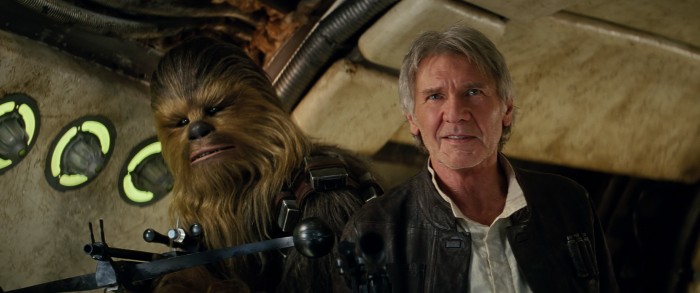 ...in order to evoke this image:
...in order to evoke this image: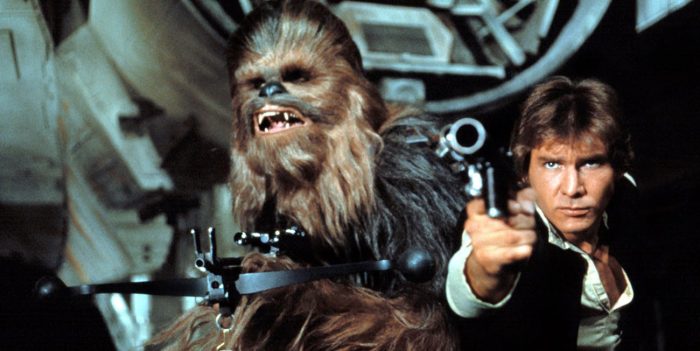 The latter isn't a photo from a scene in the film, but a publicity still, with the dynamic duo littered on lunch boxes, puzzles and T-shirts throughout the '70s. That composition of the two in marketing materials became so indelibly linked to our very idea of what Star Wars felt like that Abrams wisely incorporated it into the beginning of his own saga. The actual content of the other films was beside the point – here we were referencing what popular culture felt the saga to be rather than the content of the films themselves. With The Force Awakens, J.J. reminded us what these films meant to many; with The Rise of Skywalker, he reminded us how throughout his career, from Alias to Star Trek, he's been a gifted storyteller with the first chapter and a far less accomplished one when it comes to the middle and closing, as his tendency is to simply throw out more and more until we land somewhere, with varying degrees of satisfaction.Now, at the end, it's clear Abrams found himself in a corner after The Last Jedi, and the impetus was to throw as many things as he could just to see what would stick. This is where his proclivity for red herrings comes to the fore: "let's try something," he seems to say, "and we can always walk it back if we don't want it to be permanent." Rey walks into a room to fight a version of herself, presumably a vision like with the tree in Empire, only to then confront Kylo, who has followed her to the Moon of Endor to fight her via TIE fighter rather than his former astral projection maneuver. It's dreams-within-dreams, and for every moment that you've spent trying to figure out if things are actually there or not, it's a more frustrating experience.
The latter isn't a photo from a scene in the film, but a publicity still, with the dynamic duo littered on lunch boxes, puzzles and T-shirts throughout the '70s. That composition of the two in marketing materials became so indelibly linked to our very idea of what Star Wars felt like that Abrams wisely incorporated it into the beginning of his own saga. The actual content of the other films was beside the point – here we were referencing what popular culture felt the saga to be rather than the content of the films themselves. With The Force Awakens, J.J. reminded us what these films meant to many; with The Rise of Skywalker, he reminded us how throughout his career, from Alias to Star Trek, he's been a gifted storyteller with the first chapter and a far less accomplished one when it comes to the middle and closing, as his tendency is to simply throw out more and more until we land somewhere, with varying degrees of satisfaction.Now, at the end, it's clear Abrams found himself in a corner after The Last Jedi, and the impetus was to throw as many things as he could just to see what would stick. This is where his proclivity for red herrings comes to the fore: "let's try something," he seems to say, "and we can always walk it back if we don't want it to be permanent." Rey walks into a room to fight a version of herself, presumably a vision like with the tree in Empire, only to then confront Kylo, who has followed her to the Moon of Endor to fight her via TIE fighter rather than his former astral projection maneuver. It's dreams-within-dreams, and for every moment that you've spent trying to figure out if things are actually there or not, it's a more frustrating experience.
This Is The Way
With The Mandalorian, on the other hand, given the smaller canvas, we're actually allowed a deeper dive into esoterica. It's fan service of a different kind, respecting the past and mining its most obscure corners while making the universe feel more vast rather than a series of running coincidences and battles where only the peripheral characters are truly made to suffer ignominiously. We're about to enter uncharted territory in a post-Skywalker reign, and Star Wars films have two directions to go. One, they can tell standalone or unique stories, with the grit (and consequences!) of Rogue One. Or, they can take the more mediocre and tired direction of Solo. The Rise of Skywalker, at its worst, leans towards the latter, while The Mandalorian is reveling in its ability to be more like the former, carving out its own narrative space while still drawing strength from the massive narrative that it exists within.This, then, may be the key to "Force healing" in future iterations of Star Wars films. Much of that spirit of what's come before needs to be injected in order to make it feel part of the whole, but what truly will set these projects apart is the ways they feel of their own volition, carving out paths which surprise and unnerve as much as they placate with familiarity. If these stories are going to continue to resonate, they need to find ways of respecting the past and plowing forward (or, perhaps, backwards thousands of years). They need to be unapologetic about their key references, but never reverential about them.Not every episode has been a gem, and the reliance on The Child has been a bit of a crutch, but The Mandalorian really has shown the true spirit of what Lucas' project was meant to exhibit. It's closer in tone to A New Hope than anything, and as it continues to develop, will hopefully encourage fans to more deeply consider the aspects that made this saga work in the first place. TROS, on the other hand, feels like it's trying to please so many masters that it never coheres, resulting in a work that has blistering moments which entertain and others which frankly don't live up to close examination. This has been endemic to this franchise since 1983, when Return of the Jedi also suffered from a similarly frustrating sense of repetition, but in time those elements were accepted and the stronger parts allowed to shine. We'll take Force healing for granted, I guess, but if one looks at how the same action was accomplished in two different ways, one for small screen and the other for the multiplex, it's actually the more intimate story with the lower stakes which speaks more effectively about the potential for future Star Wars stories.

